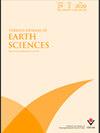Response of water resources to the Kahramanmaraş earthquakes (MW 7.7 and MW 7.6) that occurred on February 6, 2023, on the East Anatolian Fault Zone (Türkiye)
IF 1.1
4区 地球科学
Q3 GEOSCIENCES, MULTIDISCIPLINARY
引用次数: 0
Abstract
. Abstract: On February 6, 2023, two destructive earthquakes of 7.7 M W and 7.6 M W occurred in Pazarcık (Kahramanmaraş) and Elbistan (Kahramanmaraş) at 04:17 and 13:24 hours, respectively. These earthquakes caused a surface rupture with a total length of 450 km in the region with an average displacement of 3 m between the Arabian and Anatolian plates. This study was conducted to investigate the physical deformation of the aquifer system and the current water quality characteristics in the affected region utilizing field observations and on-site analysis of water sources and tap water. The study revealed significant physical changes in the karstic springs and groundwater wells, including turbidity discharges from all karstic springs due to the limestone-covered terra rosa soils in the region, destruction of groundwater wells near the coastal alluvial aquifer due to liquification, significant intrusion of sea water due to settlements caused by liquefaction in the alluvial aquifer, presence of microbiological pathogens carried by particles creating turbidity in the water sources, and presence of microbiological pathogens in some tap waters due to contamination by pollutants resulting from damage to the water and sewerage networks. These preliminary findings suggest that the earthquake-induced shaking and physical deformation impacted the quality of groundwater sources and tap water in the region.水资源对 2023 年 2 月 6 日发生在东安纳托利亚断裂带(土耳其)上的卡赫拉曼马拉什地震(7.7 级和 7.6 级)的反应
.摘要:2023 年 2 月 6 日 4 时 17 分和 13 时 24 分,分别在 Pazarcık (Kahramanmaraş) 和 Elbistan (Kahramanmaraş) 发生了两次破坏性地震,震级分别为 7.7 兆瓦和 7.6 兆瓦。这些地震在该地区造成了总长 450 千米的地表断裂,阿拉伯板块和安纳托利亚板块之间的平均位移为 3 米。本研究利用实地观察和对水源和自来水的现场分析,对受灾地区含水层系统的物理变形和当前水质特征进行了调查。研究显示,岩溶泉水和地下水井发生了重大物理变化,包括由于该地区石灰岩覆盖的红土土壤导致所有岩溶泉水出现浑浊排放,沿海冲积含水层附近的地下水井因液化而遭到破坏、冲积含水层液化造成的沉降导致海水大量渗入;颗粒携带的微生物病原体造成水源浑浊;自来水和下水道网络遭到破坏导致污染物污染,一些自来水中含有微生物病原体。这些初步研究结果表明,地震引起的震动和物理变形影响了该地区地下水源和自来水的质量。
本文章由计算机程序翻译,如有差异,请以英文原文为准。
求助全文
约1分钟内获得全文
求助全文
来源期刊

Turkish Journal of Earth Sciences
地学-地球科学综合
CiteScore
2.40
自引率
10.00%
发文量
6
审稿时长
6 months
期刊介绍:
The Turkish Journal of Earth Sciences is published electronically 6 times a year by the Scientific and Technological Research
Council of Turkey (TÜBİTAK). It is an international English-language journal for the publication of significant original recent
research in a wide spectrum of topics in the earth sciences, such as geology, structural geology, tectonics, sedimentology,
geochemistry, geochronology, paleontology, igneous and metamorphic petrology, mineralogy, biostratigraphy, geophysics,
geomorphology, paleoecology and oceanography, and mineral deposits. Contribution is open to researchers of all nationalities.
 求助内容:
求助内容: 应助结果提醒方式:
应助结果提醒方式:


